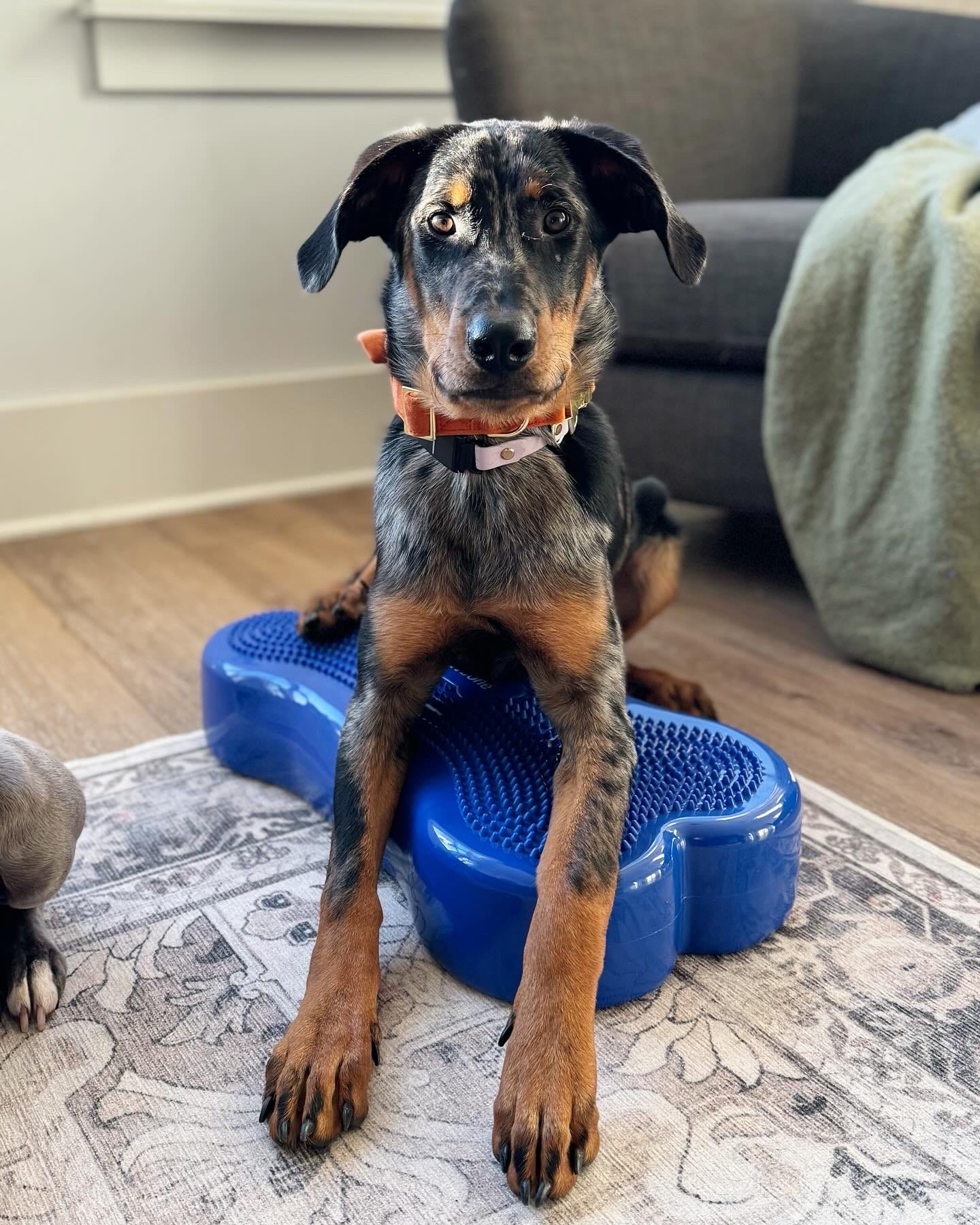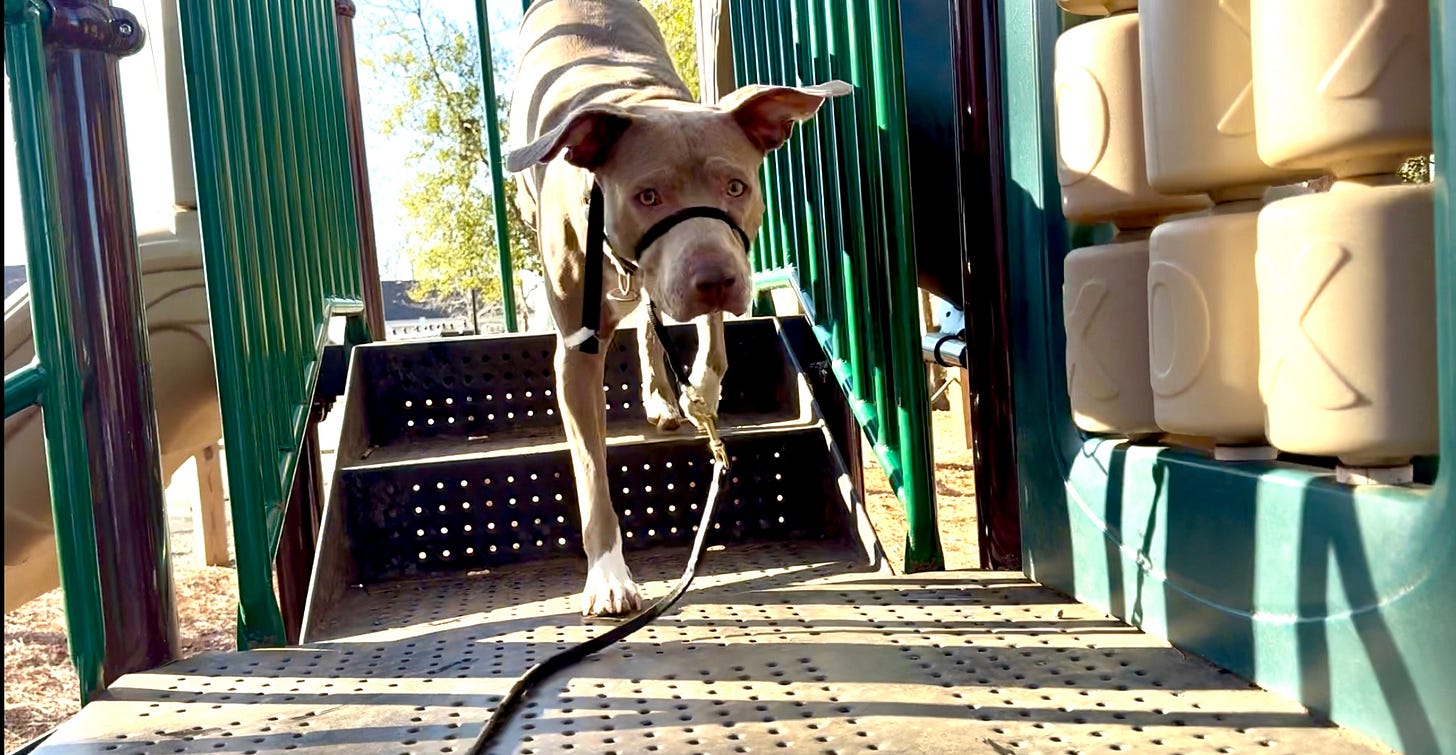Brain and Body Wins Through Environmental Agility
Build confidence and connection with this DIY dog agility hack
During a conversation with a client several years ago, I was trying to determine how to explain what I wanted them to do with their dog. “Like agility but without proper agility equipment. Just use whatever you have in your environment right now. Environmental agility.”
That conversation coined a phrase I still use today to make it easier for me to describe the following: using anything in the current environment as obstacles for a dog that will get their paws and body moving in different ways simultaneously, while inducing thought and increasing their mental and physical stimulation.
Environmental agility is putting the brain and body to work together using movements and objects such as retaining walls, park benches, playground equipment, and even in-home “equipment” like furniture, stairs, and homemade paper towel roll jumps.
I recommend implementing environmental agility to every single client I work with.
Why It’s Such a Powerful Exercise
Stress can be good, bad, or neutral. “Good stress” is known as eustress. When a dog is exposed to situations that create this type of stress, it can be a powerful confidence booster and happiness generator. Overcoming challenges and experiencing small (or big) wins leads to personal growth. If this sounds like something you’ve heard before from a therapist, life coach, or mentor, it’s because there is a lot of research on this topic as it applies to not just humans but all animals and even plants!
So, what does stress have to do with environmental agility? When you set up attainable challenges for your dog that involve both thinking and physical movement, and they overcome them, you are igniting the growth process.
The thing to know about stress is that it is individually subjective. One dog may perceive something as
easy, peasy, lemon-squeezy, and another dog may perceive it as terrifying, which is why it’s also essential to know how to put it into practice, which we’ll dive into in the next section.
First, let’s cover growth, which comes in many forms. Some of the ways that pet parents can tap into the plentiful benefits of environmental agility include the following:
Helping dogs with reactivity
Reactive dogs often fixate on their triggers - an unhealthy, involuntary behavior that doesn’t allow them to let go of the trigger and experience anything else around them in that moment. Working brain and body exercises away from triggers, then gradually closer to triggers for short periods at a safe distance over time, can help reduce the concern associated with those triggers, to the point that your pup can begin to let go and even have some fun, despite something previously triggering being present. This can open up new environments for dogs that may not have been able to experience them without tipping into distress, bad stress, which is harmful over time.
Trust Building and Confidence
When you help your dog win by overcoming small challenges, just as humans get a confidence boost from a win, your dog feels it too. What’s even better is being right by their side and encouraging them, which makes it not just a personal win but a team win for a team event. Environmental agility is a great bonding experience.
Body Awareness and Muscle Strength
Just as toddlers and children must learn to navigate their developing bodies with rapid growth, puppies and dogs do too. The difference is that while parents offer guidance and encourage toddlers to overcome mobility challenges as they learn, people don’t realize a dog may simply avoid doing something that looks physically challenging. They may not even try without encouragement, leaving their untapped physical abilities stashed away.
Environmental agility involves exploring new movements in ways that, over time, increase balance, strengthen muscles, and improve paw-eye coordination, so to speak. Aside from reducing the likelihood of injury due to improved body awareness and balance, as dogs enter their golden years, a strong and healthy body is crucial to support their joints adequately, which slowly deteriorate over time.
Behavior Beginnings For Puppies
In my Behavior Beginnings for Puppies class, I go beyond teaching obedience skills to help pet parents incorporate activities that promote the development of a well-rounded, behaviorally sound dog. While many factors influence a dog’s personality and behavior, the numerous benefits of environmental agility make it a central point worth highlighting. Puppies need everything already covered above, and environmental agility also offers the opportunity to incorporate safe social exposure and an enriching experience in many new environments while avoiding potentially fearful scenarios. Moving their body while learning their surroundings is a lovely gateway to take in an environment without becoming overwhelmed. Movement is a puppy’s friend. When there are a lot of distractions they haven’t yet learned to filter through, moving their body in ways that are enriching or mentally stimulating is an even better friend to them in the learning process than avoiding those situations or expecting more of them than they are ready and mature enough to give.
Putting it into Practice
What doesn’t kill you makes you stronger, right? Unfortunately, it’s not that simple, and you can make things worse, not better, if the challenges are too much for your dog. Avoiding scenarios that can hinder your progress and the effects of environmental agility, such as flooding, injury, and pushing too hard past the fun, can begin to have the opposite of the intended effect. So, how do you know when enough is enough or to keep going and increase the challenges for your dog?
Enlist the help of a Dog Pro - Dog behavior is complicated and often very subtle. A dog trainer or behavior professional can watch you and your dog in action to provide valuable feedback, help you advance as a team unit, and reap the full benefits without accidentally sliding into the regression zone.
Have a fun check - Look at your dog’s body language. Is it loose and waggy with a relaxed smile, likely indicating they are having a great time, or are they shrinking themselves and practicing avoidance, indicating it might not be so fun? Are they encouraging you to start the game again after a quick break, such as trotting over to the playground equipment you just tackled?
There are unlimited ways to put environmental agility into practice. Be creative with whatever is around and have fun visiting new locations to offer your dog novel mind and body experiences. Here are some examples to help get your creative juices flowing:
Jumping up onto a fallen tree and walking across it like a balance beam, then facing it perpendicularly and jumping over the log and back again.
Putting two front paws up on a tree stump or a nonslip stool, then practicing with two back paws on the same object.
Exploring playground equipment, but avoid slick surfaces.
Jumping onto a retaining wall and walking along it, then jumping up and off on cue.
Crawling under a park bench or picnic table, then jumping on and off on cue.
Indoor Option: Set up an obstacle course in your home with three challenges. Teach each challenge separately first, then add two together, then add three together to complete the series. Bridge them together by offering your dog a treat (if food motivated) for completing each obstacle separately, then advance to a treat after completing two obstacles together, and then advance to a treat or treat train after completing all three obstacles together. Examples of in-home “agility” equipment:
Sturdy furniture, such as an ottoman, on carpet to jump up and off of
Something to crawl under, such as a chair or your outstretched leg
Something to jump over, like a baby gate or a row of paper towel rolls
Practice going up and down the stairs one stair at a time, then two stairs at a time, then alternate one stair, two stairs, one stair, two stairs. Roll in waiting for eye contact in between each movement.
Using your body and teaching your dog to jump through your arm hoop.
The possibilities are endless!
Factors to Consider
Impact on joints: Avoid repetitively landing (jumping down from) high surfaces onto a hard surface, especially if your dog is under a year of age or entering their senior years. Create ways for soft landings and layer in water activities for less impact on joints.
Balance - While growth happens just slightly outside of the comfort zone, you want to avoid a scary experience. Losing their balance and falling due to a challenge that is too hard, or a surface that is too slippery or unsteady, can hinder rather than help.
Medical conditions—Back issues such as intervertebral disc disease, elbow dysplasia, and hip dysplasia require additional creativity to avoid aggravating an underlying condition. If your dog has any orthopedic concerns, talk with a professional about adapting exercises to help.
Playground equipment is for kids, not your fur kids. It's great for environmental agility, but always acquiesce to little humans and be respectful so that rules aren’t implemented disallowing dogs to partake in playground fun, too.
Rolling in Equipment
If you’ve had some creative fun utilizing your environment to move your dog’s body while stimulating their brain, but you want some actual equipment to add to the mix, there are several options. Half balance balls, shoots, A-frames, weave poles, canine fitness equipment, and cavaletti jumps are all good choices for upping your agility game with your furry best friend.

A Behavior Win
From a phrase that was born in adaptive conversation to provide positive distraction for a client’s dog, to something that I use in practice every day, environmental agility has become one of my staple go-tos for dogs that struggle with big emotions.
Environmental agility is a simple yet powerful way to support your dog's physical and mental well-being. By creatively utilizing your surroundings, you can turn everyday environments into opportunities for growth, confidence-building, and bonding. Whether you’re helping a reactive dog manage their emotions, building a puppy’s body awareness, or just looking for a fun way to engage your dog, environmental agility offers endless possibilities. Remember to keep it positive, safe, and tailored to your dog’s unique needs. Embrace the journey and enjoy watching your dog thrive as they conquer new challenges alongside you.







